| |
|
|
|
|
|
|
|
|
|
|
| |
| |
田润德
编译文/图 2020-07-23
20:36 |
|
| |
|
|
|
|
| |
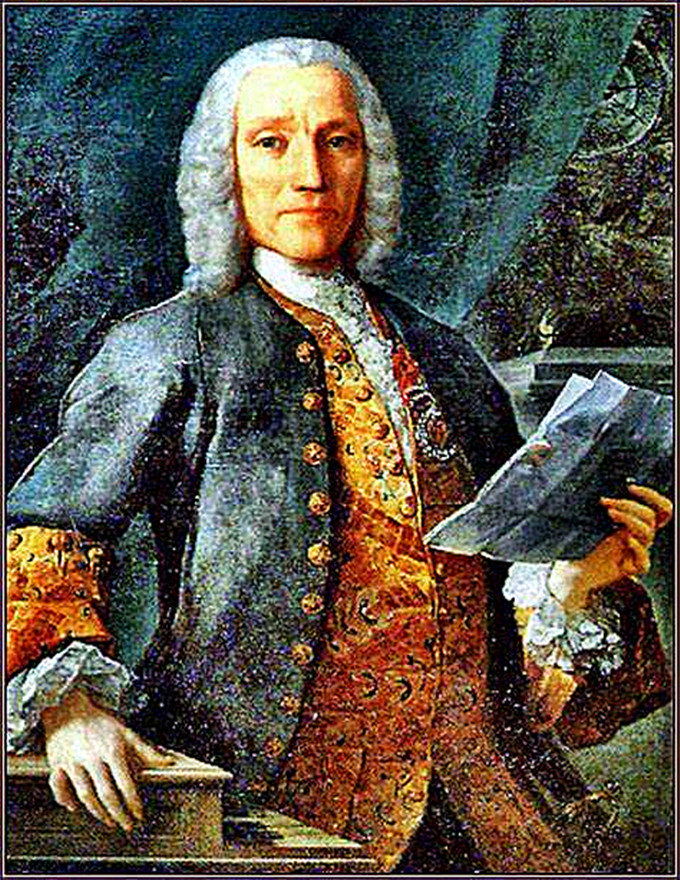 |
|
|
|
| |
多梅尼科·斯卡拉蒂 (Domenico Scarlatti
1685-1757) |
|
|
|
| |
|
|
|
|
| |
波琳娜·奥赛汀斯卡娅演奏多梅尼科·斯卡拉蒂《D小调钢琴奏鸣曲》,K.141 (2019) |
|
|
|
| |
Polina Osetinskaya - Domenico
Scarlatti: Piano Sonata in D minor, K.141 (2019) |
|
|
|
| |
曲名:D小调钢琴奏鸣曲, K. 141
作曲:多梅尼科·斯卡拉蒂 (Domenico Scarlatti)
钢琴:波利娜·奥赛汀斯卡娅 (Polina Osetinskaya)
|
|
|
|
| |
|
|
|
|
| |
音乐历史上的今天
1757年7月23日,在弹奏时第一个采用交叉双手技巧的键盘表演艺术家、曾经写过555首奏鸣曲的多梅尼科•斯卡拉蒂(Domenico
Scarlatti,1685——1757)在马德里去世,享年71岁。
多梅尼科·斯卡拉蒂[Domenico
Scarlatti]1685年10月26日出生于那不勒斯,是知名作曲家亚历山德罗·斯卡拉蒂(Alessandro
Scarlatti)的第六个孩子。16岁即任那不勒斯宫廷礼拜堂的管风琴师和乐师。两年后随父亲移居罗马,曾以乐师的身份服务于波兰女王玛利亚·卡西米、丰特斯侯爵(Marquis
de Fontes)和圣彼得大教堂。1719年移居葡萄牙,担任里斯本贵族教堂的乐师,以及国王若昂五世(King John
V)的公主葡萄牙的玛丽亚·芭芭拉(Maria
Barbara)的教师。当公主嫁到西班牙时,他又奉命随同去了马德里,并在那里度过余生,于1757年7月23日逝世于马德里。
创作的555首键盘奏鸣曲。
据信,多梅尼科大部分音乐训练来自家庭成员,但他的父亲是他生活中的主导人物。是亚历山德罗安排了多梅尼科的第一次演出,为那不勒斯的无伴奏合唱《里尔》担任管风琴手和作曲家。尽管多梅尼科在键盘音乐方面表现出了巨大的天赋,他还是希望多梅尼科继续从事声乐工作。1705年,多梅尼科被派往威尼斯,在那里他遇到了亨德尔,并于1708年前往罗马,成为被流放的波兰女王玛丽亚·卡西米拉(Maria
Casimira)的无伴奏合唱大师,后来又成为无伴奏合唱的领袖朱利亚。在这些位置上,他创作了歌剧、小夜曲和一些神圣的声乐作品。也是在罗马,他与葡萄牙大使丰特斯侯爵建立了友谊,最终导致斯卡拉蒂在1719年被葡萄牙的若昂五世任命为皇家教堂的院长。斯卡拉蒂也是皇室的老师,尤其是玛丽亚·芭芭拉公主。在来里斯本之前,斯卡拉蒂已经写了大约50首键盘曲,但他为学生们写的更多,其中还包括卡洛斯·德·塞克萨斯(Carlos
de Seixas)。玛丽亚·芭芭拉嫁给西班牙费迪南多王子时,斯卡拉蒂跟着她去了西班牙。他的第一份出版物是《三十首奏鸣曲》(30 sonatas
called "Essercizi
"),于1738年发行,并在欧洲各地销售。尽管作为国王和王后,费迪南多和玛丽亚·芭芭拉把歌剧引入了西班牙的文化生活,斯卡拉蒂却没有为他们写过歌剧。然而,他确实在他们的私人音乐晚会上提供了帮助,再次创作了康塔塔舞曲,并与法里奈利等歌手合作。斯卡拉蒂也继续教书,在他生命的最后六年里,他致力于把他的奏鸣曲整理成手稿。这些单乐章奏鸣曲被认为是键盘曲目的基石,是巴洛克和加朗特键盘写作风格之间的桥梁。他们展示了他对现代伊比利亚流行音乐节奏的适应能力,以及他在创作主题和发展有趣的和声方面的创造性。
今日视频:1、波琳娜·奥赛汀斯卡娅演奏多梅尼科·斯卡拉蒂《D小调钢琴奏鸣曲》,K.141 (2019);2、赤松林太郎演奏斯卡拉蒂
《牧歌》;3、傅聪演奏卡拉蒂奏鸣曲L108(1968)。
|
|
|
|
| |
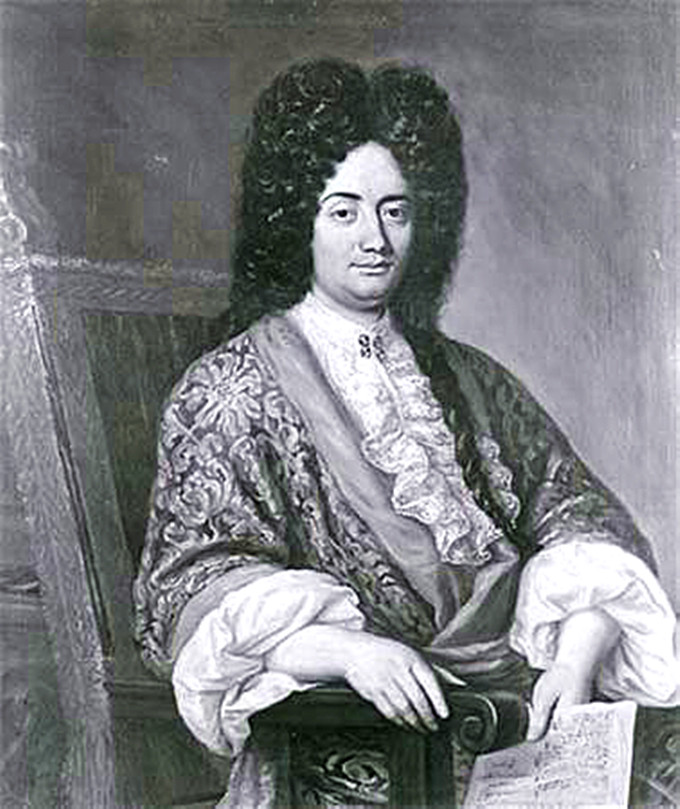 |
|
|
|
| |
亚历桑德罗·斯卡拉蒂(Alessandro
Scarlatti
) |
|
|
|
| |
斯卡拉蒂家族的名字——用不同的拼写——在西西里岛很常见,另外还有几个斯卡拉蒂家族的分支居住在罗马和意大利北部。亚历山德罗·斯卡拉蒂(1660-1725)是这个家庭的音乐基石,他成为意大利同时代最重要的歌剧作曲家。除了大约100部歌剧,他还创作了600部康塔塔,许多清唱剧,小夜曲,奏鸣曲和其他器乐作品。他帮助建立了那不勒斯作为一个主要的歌剧中心,写了令人难以置信的情感品质和死亡的音乐,并得到了他的赞助人的尊敬。我们对他早期的音乐训练所知甚少,但在他12岁的时候,他被送到罗马与亲戚住在一起,并跟随贾科莫·卡里西米学习。后来,他成为了瑞典女王克里斯蒂娜的音乐大师,随后在那不勒斯赢得了歌剧的荣誉。亚历山德罗不仅是一位多产的作曲家;他还保证自己的音乐基因会遗传给下一代。1678年4月,斯卡拉蒂与安东尼娅·安宗隆结婚,安宗隆为他生了10个孩子,其中包括极具天赋的儿子多梅尼科。 |
|
|
|
| |
The
Scarlatti family name—in various spellings—was common in Sicily,
with several branches of additional Scarlatti families residing
in Rome and northern Italy. Alessandro Scarlatti (1660-1725) was
the musical bedrock of the family, and he became the most
important opera composer of his generation in Italy. Besides
roughly 100 operas, he also composed 600 cantatas, many
oratorios, serenatas, sonatas, and other instrumental pieces. He
helped to establish Naples as a leading operatic center, wrote
music of incredible emotional quality and death, and enjoyed
great respect from his patrons. We know little about his early
musical training, but at the age of 12 he was sent to Rome to
live with relatives and to study with Giacomo Carissimi. In
time, he became maestro di capella for Queen Christina of
Sweden, and subsequently went on to grab operatic glory in
Naples. Alessandro was not merely a prolific composer; he also
assured that his musical DNA was passed on to the next
generation. In April 1678, Scarlatti married Antonia Anzalone
who would bear him ten children, including the supremely
talented son Domenico. |
|
|
|
| |
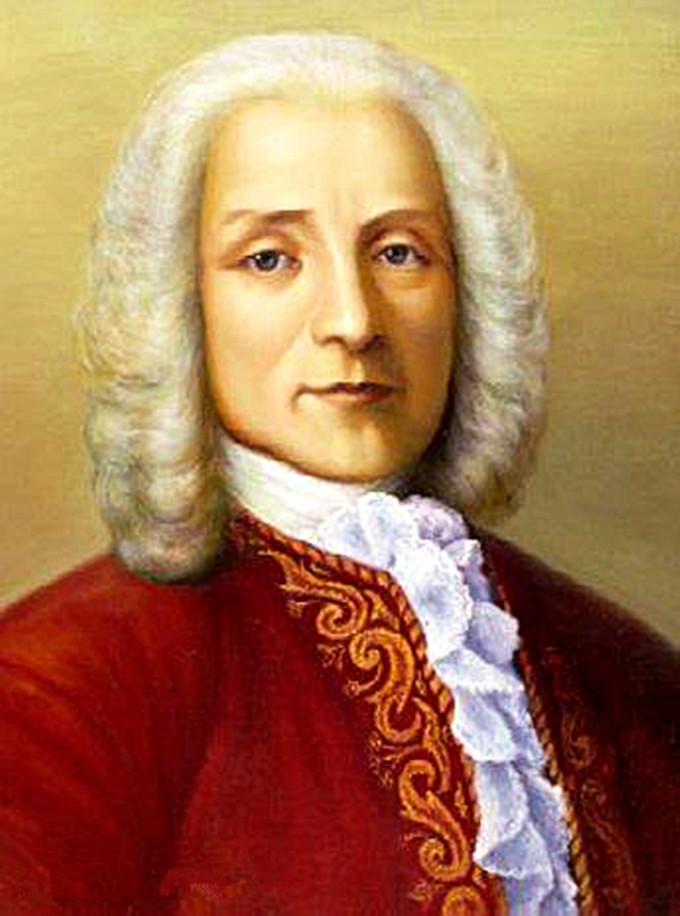 |
|
|
|
| |
多梅尼科·斯卡拉蒂 (Domenico Scarlatti
) |
|
|
|
| |
跟随他父亲的脚步,多梅尼科为1703/04那不勒斯歌剧季创作了三部歌剧。然而,他首先被派往威尼斯,在那里他遇到了亨德尔,随后于1708年出现在罗马,成为流亡的波兰女王玛丽亚·卡西米拉的音乐大师。他创作了歌剧、室内康塔塔和其他声乐。1719年,他被任命为葡萄牙若昂五世皇家教堂的一员。在抵达里斯本之前,杜梅尼科已经创作了许多键盘乐曲,并不断为他的学生创作奏鸣曲,以增加他的目录。1738年,当他的第一本名为《Essercizi》的30首奏鸣曲问世时,它在欧洲大卖。在他生命的最后6年里,他把他的键盘奏鸣曲整理成各种各样的手稿,他至今仍主要以他的555首键盘奏鸣曲而为人所知。 |
|
|
|
| |
Following
in the footsteps of his father, Domenico composed three operas
for the 1703/04 operatic season in Naples. However, he was first
sent to Venice where he met Handel, and subsequently appeared in
Rome in 1708 to became maestro di capella to the exiled queen of
Poland, Maria Casimira. He composed operas, chamber cantatas,
and other vocal music and in 1719 he received an appointment to
the royal chapel of João V of Portugal. Before arriving in
Lisbon, Domenico had already composed a number of keyboard
pieces, and he kept adding to his catalogue by producing sonatas
for his students. When his first publication, 30 sonatas called
“Essercizi” was issued in 1738, it sold like hotcakes throughout
Europe. During the last six years of his life, he organized his
keyboard sonatas into various manuscripts, and he is still
primarily remembered for his 555 works in that genre.
|
|
|
|
| |
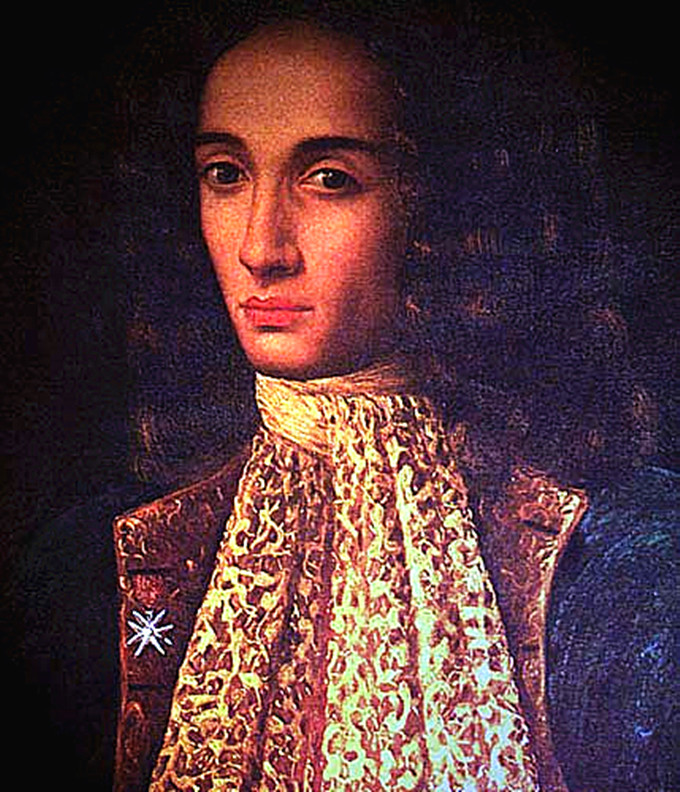 |
|
|
|
| |
皮埃特罗·菲利波·斯卡拉蒂(Pietro Filippo Scarlatti ) |
|
|
|
| |
在罗马,彼得罗·菲利波是亚历山德罗·斯卡拉蒂的长子,他在乌尔比诺大教堂担任唱诗班指挥,开始了他的音乐生涯。1708年,他的父亲把他带到那不勒斯,皮埃特罗·菲利波最初担任宫廷风琴手。然而,他也开始创作歌剧。他作为风琴手和唱诗班指挥的背景使他在歌剧舞台上表现得很好。他追随父亲的脚步,创作了色彩斑斓的和声和动人而简单的旋律。他唯一的歌剧《Clitarco》于1728年首演,但遗憾的是乐谱丢失了。他的作品还包括一些康塔塔和大量的键盘toccata。 |
|
|
|
| |
orn in
Rome, Pietro Filippo was the eldest of Alessandro Scarlatti’s
children, and he began his musical career as the choirmaster at
the cathedral of Urbino. In 1708 his father brought him to
Naples, and Pietro Filippo initially worked as the court
organist. However, he also started working on operas. His
background as organist and choirmaster served him well on the
operatic stage, and in the footsteps of his father created
multicolored sonorities and harmonies supporting attractive and
simple melodic lines. His only opera Clitarco was premiered in
1728, but the score has regrettably been lost. His oeuvre also
includes a number of cantatas and a multitude of keyboard
toccatas. |
|
|
|
| |
|
|
|
|
| |
斯卡拉蒂与《牧歌》
|
|
|
|
| |
一本古典钢琴曲集,至少要有一首多米尼科。斯卡拉蒂的曲子,不然,就几乎象一部美国历史省略了托马斯·杰斐逊、本杰明。富兰克林或亚历山大。汉密尔顿。多米尼科·斯卡拉蒂是著名音乐家亚历山德洛·斯卡拉蒂的儿子,1685年10月26日生于意大利那不勒斯,与约翰·塞巴斯蒂安。巴赫、乔治。弗雷德里克·亨德尔同年。和巴赫一样,斯卡拉蒂为键盘乐器的技巧从不必限制的束缚中解放出来做了不少工作。人们称多米尼科·斯卡拉蒂为“现代钢琴演奏之父”。他是一位熟练的羽管键琴演奏家,羽管键琴是一种意大利式的大键琴(
Harp
sichord),是现代钢琴的前身。1709年卡提耐尔。渥托波尼要斯卡拉蒂与当时访问罗马的亨德尔比赛,演奏大键琴和风琴,结果斯卡拉蒂获大键琴第一名,但他承认风琴的优势属于亨德尔。
斯卡拉蒂专心研究羽管键琴,并且尽可能使它成为一种独奏乐器。他采用了单声部曲式,在这种作品中,一只手弹旋律,另一只手用和声伴奏,而不是弹奏对位旋律。他采用了双手交叉弹奏;用优美的装饰音,如涟音、颤音和各种回转音;三度和六度的经过旬,大于一个八度的跳进;分解和弦的反向进行以及靠换手指快速重复一些音等新技术。
多米尼科是一位羽管键琴盛大键琴的多产的作曲家。除歌剧和其他作品外,他留下了大约四首短小的大键琴曲。名闻遐迩,爱尔兰都柏林教堂的管风琴师罗森格拉夫特地长途旅行来到那不勒斯,以便更好地熟悉斯卡拉蒂和他的音乐作品。
牧 歌
这首牧歌原来是为羽管键琴而作的,由卡尔·陶西格改编为现代钢琴曲。陶西格于1841年l1月4日生于华沙。李斯特认为陶西格“有钢铁般的手指,他的改编很可靠。”陶西格介绍了几种持续音,这些音在斯卡拉蒂所用的乐器上不能持续。羽管键琴既不能随意发出明亮音与柔美音,也不能发出强音和弱音,只能发一种力度和一种音质的音。那个时代的大键琴有时有两个键盘,每一个键盘有单独的一套琴弦,其中一套比另一套重。重的弦发出的音较强。但即使如此,演奏者还不能由弱到强逐渐弹奏渐强,他只能把一个乐段弹得轻一点,一个乐段弹得响一点。那就是为什么那个时代的键盘乐作品中频繁地出现回声效果的原因。
牧歌:如标题所示,这首作品表现了一种朴素的田园风光,也许是牧羊人的歌声,或者是作曲者对乡村景色的一种印象。牧歌一般用6/8拍。
在多米尼科。斯卡拉蒂的这首《牧歌》中,你可以想象能听到鸟儿的歌唱,牧童的笛声、狗吠声、羊群的咩咩声和空气中弥漫的音乐。如果适当地采用踏瓣和谐地配合手指动作,你几乎能感觉到夏日阳光的温暖,随着摇摆着的树叶的伴奏,你可隐约地听到一种轻颤的哼唱。
明亮音:旋律的明亮音应该用坚定而优美的手指动作,用极弱到中强的力度,轻快地奏出。左手和弦(如果发音极弱,用持续的手指动作轻轻抚键)的神秘泛音增加了作品织体的丰富性。
令人感兴趣的左手:左手用柔美的极弱音弹奏,右手则用明亮的中弱音弹奏,突出在左手之上,我们可清晰地听到它们丰富的色彩,这是很有趣的。它象一块鲜红色的颈巾放在蓝灰色的胸衣上:颜色协调地融合在一起,但仍能清楚地分辨如每种颜色。然而要注意,相反地,当双手用同样的音质弹奏时,许多音融合到一点,就分辨不清了。
装饰性踏瓣(制音或强音):在许多小节中,第一条踏瓣垂直线直接标记在符头下面,在同一瞬间,踩下踏瓣并击键,或击键后立即踩下强音踏瓣,用一种给人切分节奏感觉的方式。重要的是,手指压力离键以前就应踩下强音踏瓣。
从头至尾使用柔音踏瓣:掌握了音符和强音踏瓣的用法以后,用同样的方法重复练习这首牧歌。但从头至尾要踩下柔音踏瓣。操作柔音踏瓣很简单,只要把左脚的重量放在柔音踏瓣上,并忘记了这回事就行了。注意,要把色彩、音质、音色以及其他外加音乐效果都用到网样的双手、同样的钢琴、同样的乐曲,甚至同样的演奏方法中去。
|
|
|
|
| |
|
|
|
|
| |
赤松林太郎演奏斯卡拉蒂 《牧歌》(田园)K9 L413 |
|
|
|
| |
Piano performance of
Scarlatti for Pastoral K9 L413 |
|
|
|
| |
Scarlatti
and the Pastoral.
A classical piano piece, with at least one Domenico.Scarlatti's
music, otherwise, is almost like an American history with Thomas
Jefferson and Benjamin omitted.Franklin or
Alexander.Hamilton.Domenico Scarlatti was the son of the famous
musician Alessandro Scarlatti. Born in Naples, Italy, on October
26, 1685, he was married to John Sebastian.Bach,
George.Frederick Handel of the same year.Like Bach, Scarlatti
did much to liberate the skill of the keyboard instrument from
its unrestricted confines.Domenico Scarlatti has been called
"the father of modern piano playing".He was a skilled
harpsichord, the Italian predecessor to the modern
piano.Catinell in 1709.Votoponi asked Scarlatti to compete with
Handel, who was visiting Rome, to play the harpsichord and
organ. Scarlatti won the harpsichord first, but he admitted that
the organ's advantage belonged to Handel.
Scarlatti concentrated on the harpsichord and tried to make it
as a solo instrument as possible.He adopted a monophonic form,
in which one hand plays the melody and the other accompanies it
in harmony rather than counterpoint.He played with his hands
crossed;With beautiful grace notes, such as ripple, trill and
various turning notes;The passage of three and six degrees is
greater than an octave;New techniques such as the reverse
progression of broken chords and the rapid repetition of notes
by changing fingers.
Domenico was a prolific composer of harpsichord and
harpsichord.In addition to operas and other works, he left
behind about four short harpsichord pieces.It is so well known
that Rosengraf, the organist in Dublin, Ireland, made a long
journey to Naples to become better acquainted with Scarlatti and
his music.
Pastoral songs
Originally made for the harpsichord, this idyll was adapted for
the modern piano by Carl Taussig.Taussig was born in Warsaw on
the 4th of January, 1841.Liszt thinks Taussig "has steely
fingers, and his adaptation is reliable."Taussig introduced
several sustained notes that did not last on Scarlatti's
instrument.The harpsichord produces neither bright and soft
notes, nor strong and weak notes, but only one strength and one
quality.Harpsichord of that era sometimes had two keyboards,
each with a separate set of strings, one heavier than the
other.A heavy string makes a stronger sound.But even so, the
player does not go from weak to strong gradually playing
stronger, he can only play a little bit of music, a little bit
of music louder.That's why there were so many echoes in the
keyboard music of that era.
Idyllic: As the title suggests, this piece represents a simple
pastoral scene, perhaps a shepherd's song, or a composer's
impression of the countryside.Pastoral songs are usually done in
6/8 time.
In Domenico.In Scarlatti's Idyll, you can imagine hearing the
songs of birds, the pipes of shepherd boys, the barking of dogs,
the bleating of sheep and the music in the air.You can almost
feel the warmth of the summer sun if you use the right pedals in
harmony with your fingers, and you can hear a faint humming to
the swaying leaves.
Bright notes: The bright notes of a melody should be played
briskly with firm and graceful finger movements, with very weak
to medium strength.The mysterious overtones of left-hand chords
(gently stroking the keys with continuous fingering if they are
extremely weak) add richness to the texture.
Interesting left hand: the left hand is played in a soft very
weak note, while the right hand is played in a bright middle
weak note, projecting above the left hand. It is interesting to
hear their rich colors clearly.It is like a bright red
neckerchief on a blue-gray corset: the colors blend in
harmoniously, but you can still distinguish them clearly.Note,
however, that when both hands play the same tone, many sounds
merge into one and become indistinguishable.
Ornamental pedal (damper or fortic) : In many bars, the first
vertical line of pedal is marked directly under the symbol head,
and the pedal is pressed and pressed at the same instant, or
immediately after, in a manner that gives the sense of syncretic
rhythm.It is important to press down the forte pedal before the
finger pressure leaves the key.
Use the soft pedal throughout: After mastering the notes and the
strong pedal, repeat the pastoral in the same way.But tread the
soft pedal from beginning to end.Using the soft pedal is easy,
just put the weight of your left foot on the soft pedal and
forget about it.Note that color, tone quality, timbre, and other
additional musical effects are applied to networked hands, to
the same piano, to the same piece, and even to the same method
of playing. |
|
|
|
| |
 |
|
|
|
| |
多梅尼科·斯卡拉蒂 (Domenico Scarlatti
)传记封面 |
|
|
|
| |
 |
|
|
|
| |
多梅尼科·斯卡拉蒂 (Domenico Scarlatti
)唱片封面 |
|
|
|
| |
Today in
the history of music
Domenico Scarlatti (1685 -- 1757), who wrote 555 sonatas and was
the first keyboard performer to cross his hands while playing,
died in Madrid on July 23 at the age of 71.
Domenico Scarlatti was born in Naples on Oct. 26, 1685, the
sixth child of Alessandro Scarlatti, a celebrated composer.At
sixteen he was an organist and musician in the chapel of the
Court of Naples.He moved to Rome with his father two years later
and served as a musician for The Polish Queen Mary Kasimi, the
Marquis DE Fontes and St. Peter's Basilica.He moved to Portugal
in 1719 and served as musician at the Peerage Church of Lisbon
and teacher to Maria Barbara of Portugal, princess of King John
V.When the princess was married to Spain, he was sent with her
to Madrid, where he lived for the rest of his life and died on
July 23, 1757.
555 keyboard sonatas.
Domenico is believed to have received most of his musical
training from family members, but his father was the dominant
figure in his life.It was Alessandro who arranged Domenico's
first performance as organist and composer of the Naples a
cappella, Lille.Although Domenico showed great talent in
keyboard music, he hoped that Domenico would continue to work in
vocal music.In 1705 domenico was sent to Venice, where he met
Handel, and in 1708 went to Rome, where he became the exiled
Polish queen Maria Casimira's master of a cappella and later the
leader of a cappella.From these positions he composed operas,
serenades, and sacred vocal works.It was also in Rome that he
struck up a friendship with the Portuguese ambassador, the
Marquis DE Fontes, which eventually led to Scarlatti's
appointment in 1719 as dean of the Royal Church by Joao V of
Portugal.Scarlatti was also a teacher of the royal family,
especially Princess Maria Barbara.Scarlatti had written about 50
keyboard songs before coming to Lisbon, but he wrote more for
his students, including Carlos DE Seixas.When Maria Barbara
married Prince Ferdinand of Spain, Scarlatti went with her to
Spain.His first publication, 30 Sonatas called "Essercizi ", was
published in 1738 and sold throughout Europe.Although Ferdinand
and Maria Barbara introduced opera to Spanish cultural life as
king and queen, Scarlatti did not write operas for them.He did,
however, help out at their private musical soiree, composing
cantatas again and collaborating with artists such as
Farinelli.Scarlatti also continued to teach, devoting the last
six years of his life to composing his sonatas into
manuscripts.These single-movement sonatas are considered the
cornerstone of the keyboard repertoire, a bridge between baroque
and Garant keyboard writing styles.They show his adaptability to
the rhythms of modern Iberian pop music, as well as his
creativity in creating themes and developing interesting
harmonies.
1. Paulina Osetinskaya playing Domenico Scarlatti's Piano Sonata
in D Minor, K.141 (2019);2. Shintaro Akamatsu plays The Pastoral
by Scarlatti;3. Fu Cong plays The Karati Sonata L108 (1968). |
|
|
|
| |
|
|
|
|
| |
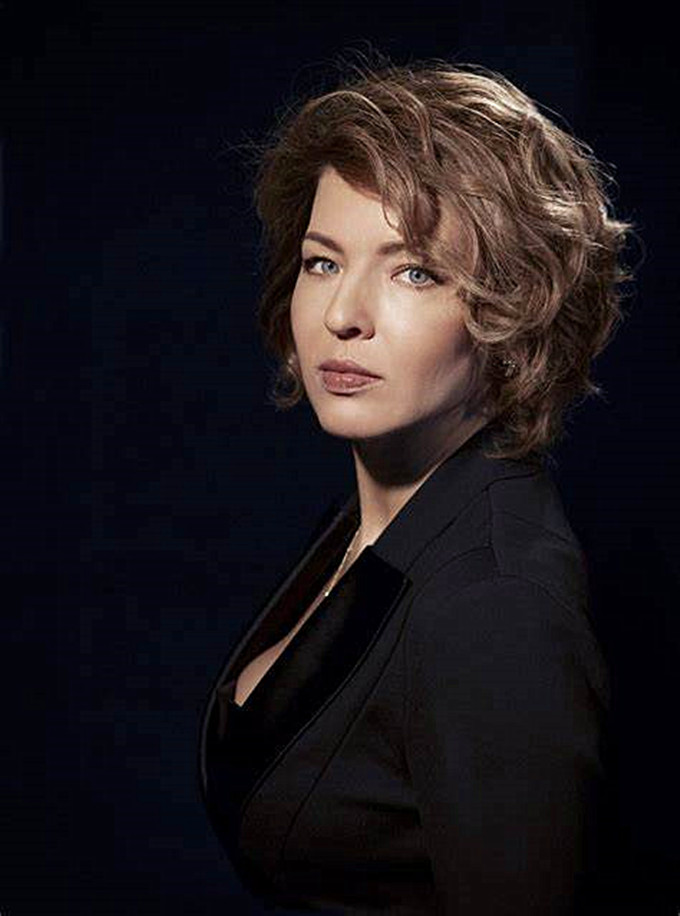 |
|
|
|
| |
波琳娜·奥西汀斯卡娅(Polina Osetinskaya) |
|
|
|
| |
波琳娜出生于莫斯科,五岁开始表演。六岁时,她在立陶宛的维尔纽斯音乐学院举办了第一场音乐会,很快就被誉为苏联的神童。后来,她继续在玛丽娜·沃尔夫的列宁格勒音乐学院和薇拉·戈尔诺斯塔娃的莫斯科音乐学院学习。
Polina Osetinskaya的舞台搭档包括Maxim Vengerov, Julian Milkis和Anton
Batagov,她还与指挥家Teodor Currentzis, Andrei Boreiko, Tugan Sokhiev, Laurent
Petitgirard, Yan Pascal Tortelier, Alexander Sladkovsky, Saulius
Sondeckis, Vassily Sinaisky合作过。
她曾出现在世界上最著名的音乐厅,包括纽约卡内基音乐厅、伦敦巴比肯音乐厅、圣彼得堡爱乐乐团、莫斯科音乐学院和维也纳音乐协会,以及罗马、东京、米兰、布鲁塞尔和美国各地的音乐厅。她还出现在许多节日在欧洲,美国,俄罗斯,意大利和以色列。2019年,她在萨尔茨堡首次亮相。
波琳娜·奥西汀斯卡娅曾与Music
Aeterna、马林斯基乐团、圣彼得堡爱乐乐团、布尔诺爱乐乐团、欧洲小交响乐团、俄罗斯联邦国家学术交响乐团、莫斯科名家乐团和东京爱乐乐团等许多乐团合作演出。
波利娜·奥赛汀斯卡娅对她的课程内容非常讲究。她的曲目非常广泛,包括巴赫和斯卡拉蒂的作品,以及当代家庭作曲家的作品,如瓦伦丁·西尔维斯洛夫,列昂尼德·德斯雅特尼科夫,Arvo部分,乔治·佩雷西斯和帕维尔·卡曼诺夫。她与许多唱片公司合作,包括Quartz,
Naxos, Sony Music, Bel Air和Melodiya。
2008年,奥西汀斯卡娅写了自传《告别,悲伤!》这本书成了畅销书。此外,她还与俄罗斯艺术家一起运营着几个创意和慈善项目。
这位艺术家在2019-2020赛季的行程包括美国和以色列巡演,在维恩、基辅、明斯克以及莫斯科、圣彼得堡、波尔姆、库尔斯克、弗拉基米尔、叶卡捷琳堡等俄罗斯城市举办音乐会。 |
|
|
|
| |
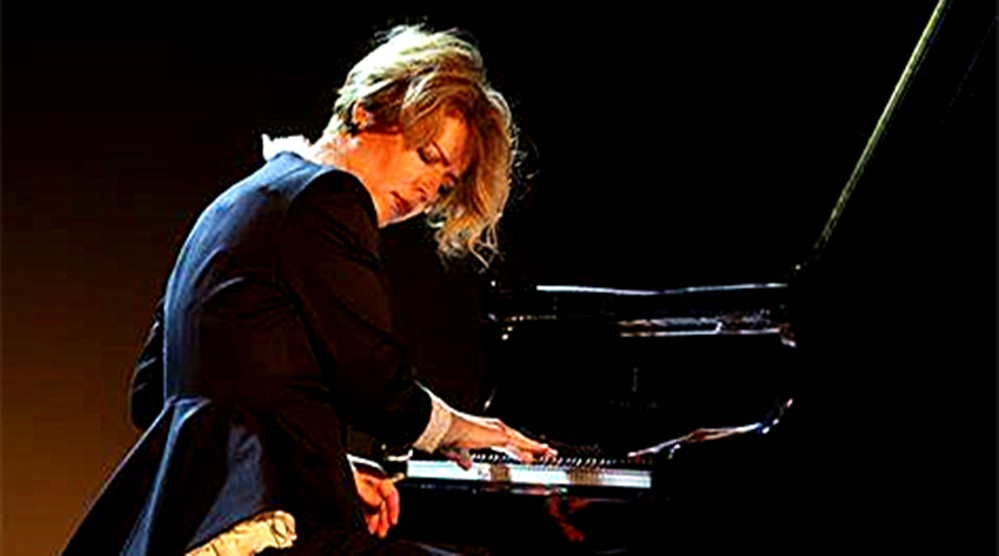 |
|
| |
波琳娜·奥西汀斯卡娅(Polina Osetinskaya)在演奏中 |
|
|
|
| |
Polina
Osetinskaya was born in Moscow, and began performing at the age of five.
She gave her first concert at the age of six at the Vilnius Conservatory
in Lithuania, and was soon acclaimed as a Wunderkind in the Soviet
Union. Later, she continued her studies at the Leningrad Conservatory
under Marina Wolf and at the Moscow Conservatory under Vera Gornostaeva.
Polina Osetinskaya’s onstage partners have included Maxim Vengerov,
Julian Milkis and Anton Batagov, and she has worked with conductors such
Teodor Currentzis, Andrei Boreiko, Tugan Sokhiev, Laurent Petitgirard,
Yan Pascal Tortelier, Alexander Sladkovsky, Saulius Sondeckis, Vassily
Sinaisky.
She has appeared at the world’s most famous concert halls, including
Carnegie Hall in New York, the Barbican in London, the St Petersburg
Philharmonic, the Moscow Conservatory and the Musikverein in Vienna, as
well as at various venues in Rome, Tokyo, Milan, Brussels and throughout
the USA. She has also appeared at many festivals in Europe, the USA,
Russia, Italy and Israel. In 2019, she made her debut in Salzburg.
Polina Osetinskaya has performed with ensembles such as MusicAeterna,
Mariinsky Orchestra, St. Petersburg Philharmonic Orchestra, the Brno
Philharmonic, the European Sinfonietta, the State Academic Symphony
Orchestra of the Russian Federation, the Moscow Virtuosi and the Tokyo
Philharmonic Orchestra and many others.
Polina Osetinskaya is very particular about the content of her
programs. Her repertoire is very wide-ranging, incorporating works from
Bach and Scarlatti to pieces by contemporary home composers such as
Valentin Silvestrov, Leonid Desyatnikov, Arvo Part, Georgs Pelecis and
Pavel Karmanov. She has collaborated with many recording companies
including Quartz, Naxos, Sony Music, Bel Air and Melodiya.
In 2008, Osetinskaya wrote her autobiography, Farewell, Sadness!, which
became a bestseller. In addition, she runs several creative and charity
projects with Russian artists.
The artist’s engagements for the 2019–2020 season include a tour of the
USA and Israel, concerts in Wien, Kiev, Minsk and in many Russian
cities: Moscow, Saint-Petersburg, Perm, Kursk, Vladimir, Yekaterinburg. |
|
|
|
| |
|
|
|
|
| |
钢琴是我一生的“情人”——傅聪/莫扎特之旅
编译 |
|
|
|
| |
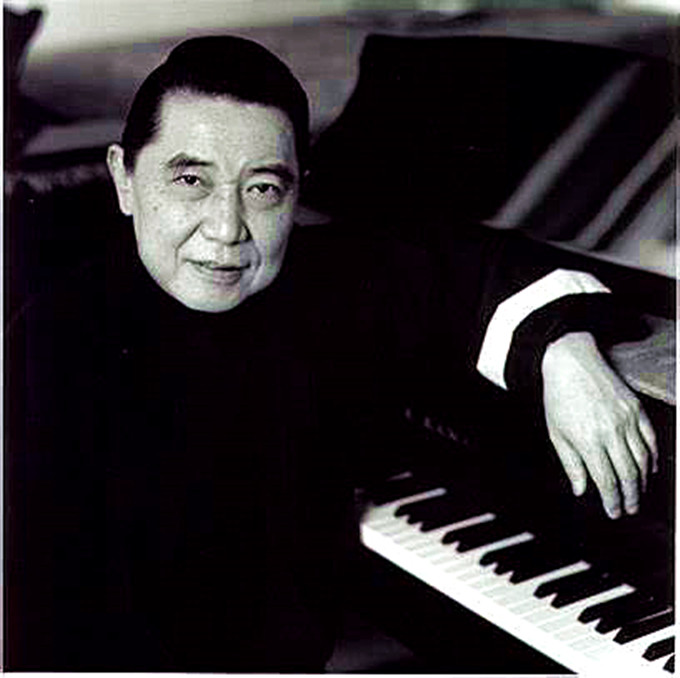 |
|
|
|
| |
傅聪,1934年3月10日生于上海,8岁半开始学习钢琴,9岁师从意大利钢琴家梅百器。1954年赴波兰留学。1955年3月获“第五届肖邦国际钢琴比赛”第三名和“玛祖卡”最优奖。1959年起为了艺术背井离乡,轰动一时,此后浪迹五大洲,只身驰骋于国际音乐舞台,获得“钢琴诗人”之美名。
傅聪在国际乐团受尊敬的程度,远远生于其它大师,上世纪六七十年代,他曾是美国时代周刊和国际重要的音乐杂志封面人物,直到现在世界上许多钢琴家,仍常常向他求教,世界重要的钢琴大赛,他是理所当然的评委。
钢琴,是傅聪的终身“情人”;音乐,是他灵魂的避难所。
过去,对时间一向吝啬的傅聪,每天近11个小时与钢琴“促膝谈心”,而且绝不允许任何人打扰。
傅聪的情感世界,孤独而多彩,但永远对外人封闭。不过,朋友还是透露了他的一个小秘密。在傅聪卧室的床头,挂着一幅初恋女友的素描画像。那是早年傅聪前往波兰学习时,女友亲笔画好后送给他的。没想到,这幅素描画像竟成了他一生美丽的记忆。
浪漫、唯美的天性让傅聪经历了3次婚姻生活。后来,在钢琴家鲁普的介绍下,傅聪结识了在香港长大的钢琴家卓一龙,两人结婚后,傅聪漂泊的“航船”,才停靠进了平静的港湾。一家四口生活在伦敦,其乐融融。遗憾的是他的两个儿子尽管非常喜欢音乐,却没有继承他的“衣钵”。
三四岁时的傅聪,已能感受到音乐的强大吸引力,显露出对音乐不寻常的热爱。七岁半时被父亲的挚友雷垣发现其极高的音乐天赋,从此傅雷打消了让傅聪学画的念头,转而拜雷垣为师,学习弹奏钢琴。
九岁半时傅聪拜
意大利指挥家、钢琴家,时任“上海工部局交响乐队”指挥的梅帕器(Mario Paci)为师。梅帕器是李斯特的再传弟子。傅聪在其门下受教三年。
傅聪于1951年夏再拜苏籍钢琴家勃隆斯丹(Ada
Bronstein)夫人为师。傅聪刻苦用功,每天练琴七八个小时,在酷暑天气,衣裤尽湿,也不稍休。而他对音乐的理解也显出有独到之处。
1953年,第四届“世界青年联欢节”在罗马尼亚举行。经国内选拔,傅聪作为中国选手参加“联欢节”
的钢琴比赛,结果获三等奖。当时他演奏的斯克里亚宾的《前奏曲》,曾将苏联选手感动得不禁泪下。 |
|
|
|
| |
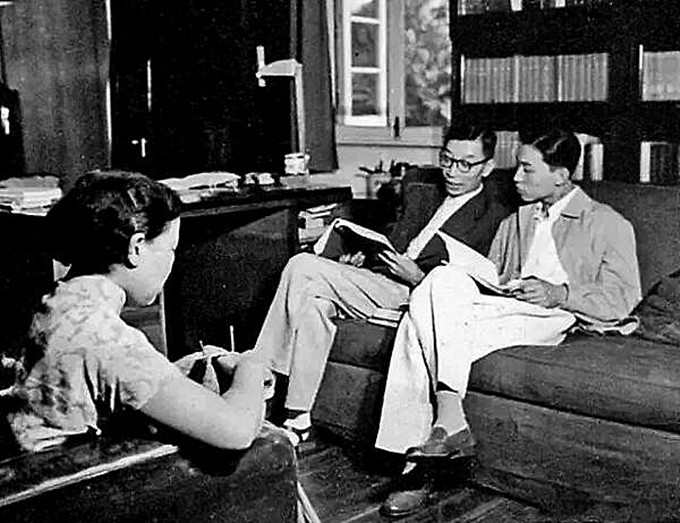 |
|
| |
傅聪和爸爸妈妈在一起的日子 |
|
|
|
| |
|
|
|
|
| |
【傅聪】卡拉蒂奏鸣曲L108 Domenico Scarlatti Sonata 1968
|
|
|
|
| |
|
|
|
|
| |
未得原作者编者授权严禁转载www.mt77.com任何内容 |
|
|
|
|
|
|
|
|
|
|
|
|
|
|



